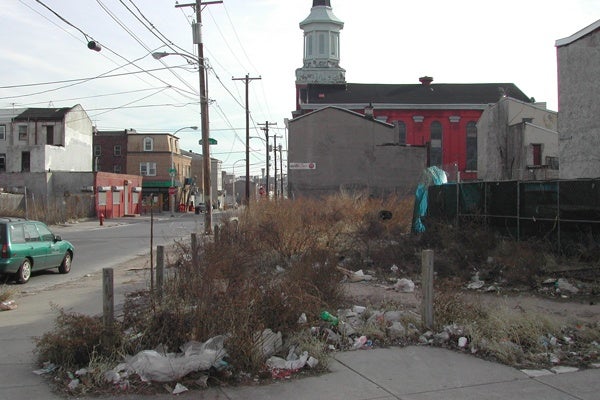Numbers back up hunch: Greening lots improves neighborhood health
Health researchers have long suspected that “cleaning and greening” overgrown, vacant lots does a neighborhood good, now they have gathered mounting — and solid evidence — that transforming nuisance properties pays off in health dividends.
For more than a decade, Philadelphia has paid the Pennsylvania Horticultural Society to rehabilitate neighborhood nuisance lots. The group now cares for about 8,000 rehabilitated properties.
“We see children walk down the middle of the street because it’s too dangerous to walk down by a vacant lot that’s heavily weeded,” said society director Bob Grossmann. “It’s a convenient place for drug dealers to stash their drugs and weapons, when the lot is cleaned and kept mowed, there’s no place to do that.”
Grossmann said clearing vermin and piled-up debris reveals a lot’s potential to local property developers and neighbors, like Andre Mears.
This fall, the society cleared a lot across from the 66-year-old home near Temple University in Eastern North Philadelphia.
“The ones that aren’t cleaned up, they have been eyesores,” Mears said. “People had the tendency to just throw trash. You are going to see trash and tires and what have you, I think there is a respect for when it’s maintained.”
Grossmann rejects the idea that the society is an “outside” group that swoops into a neighborhood to fix things without community buy in.
“I get maybe six calls a day from people asking me to come out and do the lot adjacent to their house,” Grossmann said. “We take great care to talk to neighborhood residents when we do our work, many of our contractors are residents from that neighborhood.”
And Grossmann said, his team comes back–over and over–to make sure properties are maintained.
In a new study published in the journal “Injury Prevention,” physician researcher Eugenia Garvin and colleagues measured crime and people’s perceptions of safety near vacant lots.
It is the first “look-ahead” randomized controlled trial of vacant lot greening, Garvin said. But the study was small: the team from the University of Pennsylvania interviewed just 21 people and tracked police-reported crime data near just two lot clusters.
Garvin said urban planners and health officials have “scarce dollars” and want more than a hunch that they’re making a good investment. The scientific certainty of a “gold standard” study begins to provide that evidence to policy makers, she said.
Philadelphia has budgeted $2.8 million on its LandCare program this fiscal year, according to a city spokesman.
“They want to spend their money on things that have the best evidence, that it’s going to impact people’s lives,” Garvin said.
“If people don’t feel safe in their neighborhoods, they are not going to walk,” said Garvin, an emergency room doctor. “They are not going to engage in physical activity outside which is something that’s so important for cardiovascular health.”
Violence prevention and neighborhood safety are “health issues” on their own but Garvin says she also believes greening and cleaning have the potential to boost heart health and curb obesity.
The thinking behind that leap comes from something called the allostatic load theory.
The idea is that people who have chronic exposure to acutely stressful events, such as violence in neighborhoods or being constantly fearful experience changes in their neuroendocrine system, Garvin said, and that can lead to poorer health.
“When you look at vacant lot greening to reduce crime and improve safety, you’re looking at a relatively inexpensive intervention that can impact a wide range of people in the neighborhood,” she said.
In another arm of the research, Garvin’s team is studying whether stress indicators change when neighbors spend time near overgrown, vacant lots.
“We walked people around their neighborhoods and monitored their heart rate,” Garvin said. The researchers are still crunching the numbers on those results.
WHYY is your source for fact-based, in-depth journalism and information. As a nonprofit organization, we rely on financial support from readers like you. Please give today.



